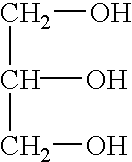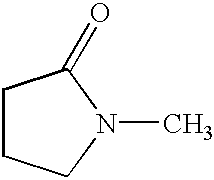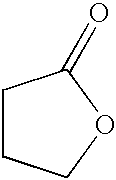[0094] Further, the fact that, for the dyed medium such as
acrylic resin,
gelatin resin or the like which locally includes portions exhibiting hydrophilic property such as ester linkage,
peptide linkage or the like in the molecules (
macro-molecules), N-methyl-2-pyrrolidone or .gamma.-butyrolactone which is used as the dyeing-
promoter agent includes
peptide linkage and ester linkage in the inside of the molecule also increases the affinity between the dyed medium and the dyeing-
promoter agent so that the
permeation of the dye into the inside of the dyed media is accelerated. For example, even when four-membered ring, six-membered ring or seven-membered ring having ester linkage or
peptide linkage (
caprolactam C.sub.6H.sub.11NO, for example) is used in place of N-methyl-2-pyrrolidone or .gamma.-butyrolactone having the five-membered ring, the advantageous effects intended by the present invention can be obtained. Further, with respect to compounds having ester linkage or peptide linkage, to compare the molecular structures of these compounds, it is preferable to use substance which has side chains longer than the
straight chain structure as the dyeing-promoter agent.
[0095] It is further preferable to use substance which has the ring structure as the dyeing-promoter agent.
[0096] Accordingly, on the assumption that the molecules of the dyeing-promoter agent are coordinated in the dye molecules in the coloring step of the color filters FIL, it is recommendable to use the compound having the molecular structure which is expanded in two dimensions compared to
straight chain molecules as the dyeing-promoter agent. Here, the compounds which are used as the above-mentioned volatility-adjusting agent or the dyeing-promoter agent may be suitably transformed into other compounds depending on the kind of
solvent into which the dye is dispersed. When the solvent is low
alcohol or
aldehyde, elements which constitute the ester linkage or the peptide linkage of the dyeing-promoter agent may be modified by the
alkyl group. When the dyeing-promoter agent or the dyed medium includes the peptide linkage or ester linkage, the material exhibits characteristic peaks in the
nuclear magnetic resonance spectrum and the infra red spectrum. With respect to the compositions of the dye, the volatility-adjusting agent, the dyeing-promoter agent and the solvent in the ink, respective weight percent values of respective materials can be specified based on the respective peak areas thereof in view of the difference of retention times of the peaks appearing in the spectra using a
gas chromatography analyzer. Further, the ink according to the present invention may generate
colloid when the ink is dropped into the phosphoric solvent (oil or the like).
[0097] As other criteria for selecting compounds which can be used as the dyeing promoter agent, it is preferable to focus on a point that the
boiling point (corresponding to the volatility) of the dyeing-promoter agent is higher than that of the volatility-adjusting member and is higher than that of the solvent or a point that the
viscosity of the dyeing-promoter agent is lower than that of the volatility-adjusting agent.
[0098] In an example which combines glycerin as the volatility-adjusting agent and N-methyl-2-pirrolidone as the dyeing-promoter agent, the
boiling point of the former is 290.degree. C. and the
boiling point of the latter is 202.degree. C. Further, with respect to the
viscosity, a capillary is prepared by
processing a
glass tube, given quantities of respective liquids are filled in the capillary under the same environment (conditions such as temperature, humidity,
atmospheric pressure or the like at the time of an experiment being set equal), and the magnitude of the viscosity was confirmed by measuring the time necessary for respective liquids to pass through the capillary. The volatility-adjusting agent which composes the ink according to the present invention is required to perform the function of suppressing the
drying of ink within a period from a point of time that the ink is adhered to the surface of the dyed media to the point of time that the dye contained in the ink permeates into the inside of the dyed media to some extent. Further, the volatility-adjusting agent which composes the ink according to the present invention is required to perform the function of preventing the scattering of the ink in the process for ejecting the ink toward the surface of the dyed medium from the
nozzle of the ink supply device. To take these request into consideration, it is requested that the boiling point of the volatility-adjusting agent is elevated above a given level with respect to the former request and it is requested that the viscosity of the volatility-adjusting agent is increased above a given level with respect to the latter request. However, these limitations may be alleviated depending on the improvement of the
permeation characteristics of the dye into the inside of the dyed media due to the dyeing-promoter agent and the enhancement of the
nozzle shape of the ink supply device.
[0099] That is, even when the combination of respective reagents used as the volatility-adjusting agent and the dyeing-promoter agent does not satisfy either one or both of these conditions, there still exists a possibility that an advantageous effects intended by the present invention can be obtained.
 Login to View More
Login to View More 


